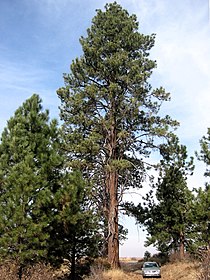Klamath Basin National Wildlife Refuges Complex
| Klamath Basin National Wildlife Refuge Complex | |
|---|---|
|
IUCN category IV (habitat/species management area)
|
|

Ponderosa Pine, Klamath Marsh
|
|
| Location | Oregon and California, United States |
| Nearest city | Klamath Falls, OR |
| Coordinates | 41°56′48″N 121°33′54″W / 41.94667°N 121.56500°WCoordinates: 41°56′48″N 121°33′54″W / 41.94667°N 121.56500°W |
| Area | 192,000 acres (780 km2) |
| Established | 1908 |
| Governing body | United States Fish and Wildlife Service |
The Klamath Basin National Wildlife Refuge Complex is a wildlife preserve operated by the United States Fish and Wildlife Service in the Klamath Basin of southern Oregon and northern California near Klamath Falls, Oregon. It consists of Bear Valley, Klamath Marsh and Upper Klamath National Wildlife Refuge (NWR) in southern Oregon and Lower Klamath, Tule Lake, and Clear Lake NWR in northern California.
Lower Klamath NWR, established in 1908, was the first waterfowl refuge in the United States. Consisting of 46,900 acre (190 km2), it includes shallow freshwater marshes, open water, grassy uplands, and croplands that are intensively managed to provide feeding, resting, nesting, and brood rearing habitat for waterfowl and other water birds.
Clear Lake NWR, established in 1911, has an area of 46,460 acres (188.0 km2). About 20,000 acres (81 km2) is open water. The balance is the surrounding upland habitat of bunchgrass, low sagebrush, and juniper.
Upper Klamath NWR, established in 1928, is composed of 15,000 acres (61 km2) of mostly freshwater marsh and open water.
Tule Lake NWR, established in 1928, encompasses 39,116 acres (158.30 km2) of mostly open water and croplands.
Klamath Marsh NWR, established in 1958, consists of 40,646 acres (164.49 km2) of freshwater marsh and adjacent meadows.
Bear Valley NWR, established in 1978, protects a vital night roost site for wintering bald eagles. It consists of 4,200 acres (17 km2) of largely old growth ponderosa pine, incense-cedar, white fir and Douglas-fir forest.
...
Wikipedia

